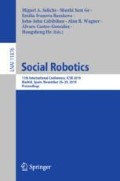Abstract
This paper presents an exploratory study consisting of a series of Robot-Mediated Therapy (RMT) sessions utilizing a humanoid NAO robot with five children with a severe form of autism for two weeks. The focus on RMT for children with low-functioning autism (LFA) was motivated by a relative neglect of Robot-Assisted Therapy efforts to address additional challenges facing individuals with LFA such as impairments of language and intellectual ability. Children aged 4–8 years old attended six 15-min sessions that included different types of applications programmed on the robot. The cumulative results obtained from the observations and interviews of the participants’ parents did not demonstrate significant progress in their social skills. Also, this paper explains the challenges and provides recommendations for further improvements of patient-centered interaction design in the area of RMT tailored for children with a severe form of autism.
Access this chapter
Tax calculation will be finalised at checkout
Purchases are for personal use only
References
Dautenhahn, K.: Robots as social actors: aurora and the case of autism. In: Proceedings CT99, The Third International Cognitive Technology Conference, August, San Francisco, vol. 359, p. 374 (1999)
Richardson, K., et al.: Robot enhanced therapy for children with autism (dream): a social model of autism. IEEE Technol. Soc. Mag. 37(1), 30–39 (2018)
Tleubayev, B., Zhexenova, Z., Zhakenova, A., Sandygulova, A.: Robot-assisted therapy for children with ADHD and ASD: a pilot study. In: Proceedings of the 2019 2nd International Conference on Service Robotics Technologies, pp. 58–62. ACM (2019)
Boucher, J., Mayes, A., Bigham, S.: Memory, language and intellectual ability in low-functioning autism (2008)
Morrier, M.J., et al.: Brief report: relationship between ADOS-2, module 4 calibrated severity scores (CSS) and social and non-social standardized assessment measures in adult males with autism spectrum disorder (ASD). J. Autism Dev. Disord. 47(12), 4018–4024 (2017)
Ousley, O., Cermak, T.: Autism spectrum disorder: defining dimensions and subgroups. Current Dev. Disord. Rep. 1(1), 20–28 (2014)
Boccanfuso, L., Scarborough, S., Abramson, R.K., Hall, A.V., Wright, H.H., O’Kane, J.M.: A low-cost socially assistive robot and robot-assisted intervention for children with autism spectrum disorder: field trials and lessons learned. Auton. Rob. 41(3), 637–655 (2017)
Zorcec, T., Robins, B., Dautenhahn, K.: Getting engaged: assisted play with a humanoid robot kaspar for children with severe autism. In: Kalajdziski, S., Ackovska, N. (eds.) ICT 2018. CCIS, vol. 940, pp. 198–207. Springer, Cham (2018). https://doi.org/10.1007/978-3-030-00825-3_17
Tapus, A., et al.: Children with autism social engagement in interaction with nao, an imitative robot: a series of single case experiments. Interact. Stud. 13(3), 315–347 (2012)
Robins, B., Dautenhahn, K., Dickerson, P.: From isolation to communication: a case study evaluation of robot assisted play for children with autism with a minimally expressive humanoid robot. In: Second International Conferences on Advances in Computer-Human Interactions, pp. 205–211. IEEE (2009)
Taheri, A., Meghdari, A., Alemi, M., Pouretemad, H.: Human-robot interaction in autism treatment: a case study on three pairs of autistic children as twins, siblings, and classmates. Int. J. Social Robot. 10(1), 93–113 (2018)
Wood, L.J., Robins, B., Lakatos, G., Syrdal, D.S., Zaraki, A., Dautenhahn, K.: Developing a protocol and experimental setup for using a humanoid robot to assist children with autism to develop visual perspective taking skills. Paladyn J. Behav. Rob. 10(1), 167–179 (2019)
Acknowledgement
We would like to express our gratitude to the administration and staff of the Republican Children’s Rehabilitation Center for their immense help to conduct these research experiments.
Author information
Authors and Affiliations
Corresponding author
Editor information
Editors and Affiliations
Rights and permissions
Copyright information
© 2019 Springer Nature Switzerland AG
About this paper
Cite this paper
Telisheva, Z., Turarova, A., Zhanatkyzy, A., Abylkasymova, G., Sandygulova, A. (2019). Robot-Assisted Therapy for the Severe Form of Autism: Challenges and Recommendations. In: Salichs, M., et al. Social Robotics. ICSR 2019. Lecture Notes in Computer Science(), vol 11876. Springer, Cham. https://doi.org/10.1007/978-3-030-35888-4_44
Download citation
DOI: https://doi.org/10.1007/978-3-030-35888-4_44
Published:
Publisher Name: Springer, Cham
Print ISBN: 978-3-030-35887-7
Online ISBN: 978-3-030-35888-4
eBook Packages: Computer ScienceComputer Science (R0)

